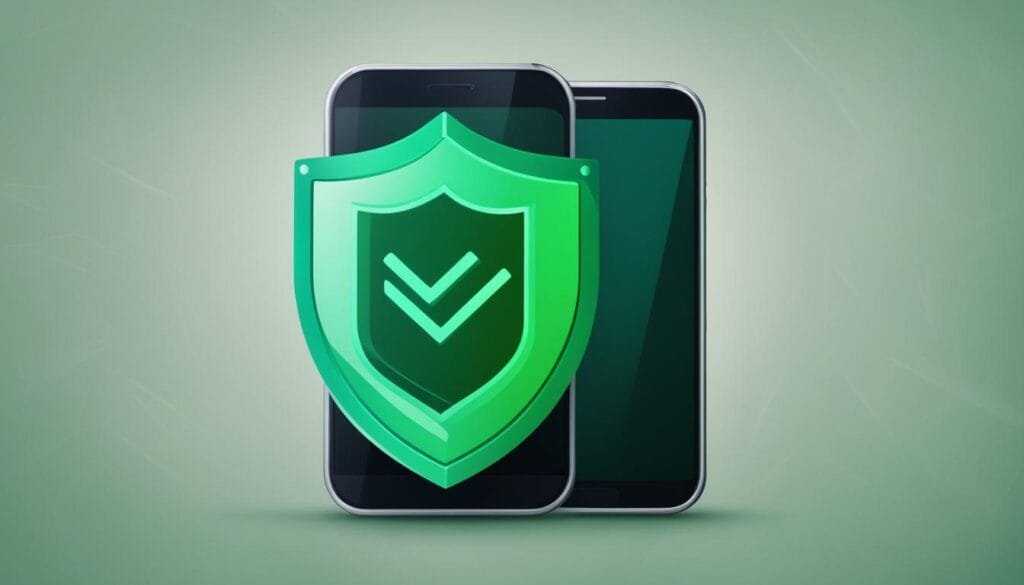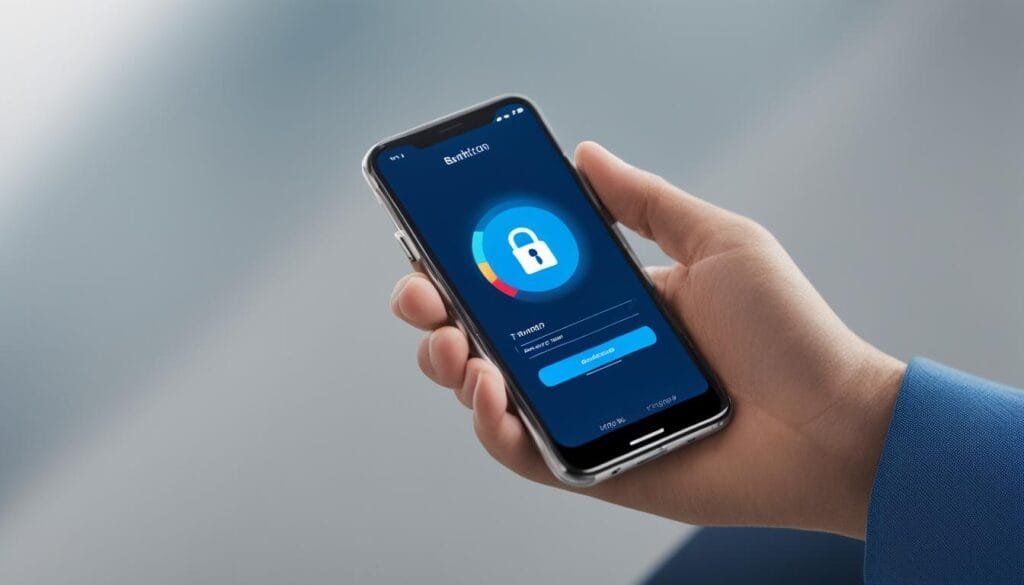In today’s digital age, mobile banking has become an integral part of our lives. With the convenience of accessing financial services anytime, anywhere, it’s no wonder that mobile banking apps are soaring in popularity. However, alongside this convenience comes the need for robust security measures to protect sensitive data and ensure a secure mobile banking experience.
Cryptography, a branch of mathematics and computer science, plays a crucial role in mobile banking security. It involves the use of encryption, authentication, and data protection techniques to safeguard financial transactions and personal information from unauthorized access and manipulation. By using encryption algorithms and secure communication protocols, cryptography ensures that your data remains private and secure throughout the entire mobile banking process.
Key Takeaways:
- Encryption is essential for secure mobile banking, protecting sensitive data from unauthorized access.
- Cryptography provides encryption, authentication, and data protection, keeping financial transactions and personal information safe.
- Secure communication protocols like SSL and TLS are crucial for maintaining the integrity of mobile banking transactions.
- Regularly updating encryption methods and following best practices for authentication enhance mobile banking security.
- By leveraging encryption and authentication, mobile banking apps can provide a secure and trustworthy banking experience.
What is Mobile Banking Security?
Mobile banking security is essential for protecting financial transactions and personal information in the digital age. With the widespread use of mobile devices for banking purposes, it’s crucial to understand the measures in place to ensure the safety and security of sensitive data. One of the key components of mobile banking security is cryptography.
Cryptography refers to the practice of using encryption, authentication, and data protection techniques to safeguard information from unauthorized access or manipulation. In the context of mobile banking, cryptography plays a vital role in securing financial transactions and personal information.
Through encryption, sensitive data is scrambled into unreadable form, ensuring that only authorized parties can decrypt and access the information. Authentication mechanisms verify the identities of users, preventing unauthorized access to accounts. Data protection techniques, such as secure data storage and transmission protocols, protect information during storage and communication.
Why is Mobile Banking Security Important?
Mobile banking security is of utmost importance due to the sensitive nature of the data involved. Financial transactions, personal information, and account details are susceptible to various threats, including hacking, identity theft, and data breaches. Without robust security measures like cryptography, the risk of unauthorized access and misuse of this information increases significantly.
By implementing strong mobile banking security measures, such as encryption and authentication, financial institutions and users can mitigate the risk of unauthorized access and protect sensitive data. These security measures ensure the integrity and confidentiality of financial transactions and personal information, making mobile banking a safe and secure option for users.
| Benefits of Mobile Banking Security | Challenges in Mobile Banking Security |
|---|---|
|
|
Why cryptography matters in mobile banking
Cryptography plays a crucial role in ensuring the security of mobile banking transactions. It provides multiple layers of protection to keep sensitive data private and secure. Here are some key reasons why cryptography is essential in mobile banking security:
Data Privacy
Cryptography ensures the privacy of data by encrypting it. Encryption transforms the data into an unreadable format that can only be deciphered with the correct decryption key. This prevents unauthorized access to sensitive information, such as account numbers, passwords, and personal details. With cryptography, mobile banking users can trust that their data remains confidential.
Data Integrity
Another vital aspect of cryptography in mobile banking is ensuring data integrity. Cryptographic algorithms use checksums and hash functions to verify that data has not been altered or tampered with during transmission or storage. This helps protect against unauthorized modifications, ensuring the accuracy and reliability of financial transactions.
Authentication
In mobile banking, cryptography plays a crucial role in authentication. It verifies the identity of users and ensures that only authorized individuals can access their accounts or perform transactions. Cryptographic techniques, such as digital signatures and public-key infrastructure, enable secure authentication, minimizing the risk of fraudulent activities.
Cryptography is a fundamental component of mobile banking security, providing data privacy, data integrity, and authentication. By implementing robust cryptographic measures, banks and financial institutions can safeguard their customers’ information and ensure a secure mobile banking experience.
| Cryptography Benefits in Mobile Banking |
|---|
| Data Privacy |
| Data Integrity |
| Authentication |
How to Secure Mobile Banking with Cryptography
To ensure secure mobile banking, implementing strong encryption methods and secure communication protocols is crucial. Here are some key practices to secure mobile banking with cryptography:
- Choose robust encryption methods: Select encryption methods like AES-256, which provides a high level of security and has been widely adopted in the industry.
- Implement secure communication protocols: Utilize protocols like SSL (Secure Sockets Layer) and TLS (Transport Layer Security) to establish encrypted connections between mobile banking apps and servers. These protocols protect data during transmission, preventing unauthorized access.
- Utilize digital signatures: Digital signatures help ensure the authenticity and integrity of mobile banking transactions. They provide a way to verify the identity of the sender and detect any tampering with the transmitted data.
- Enable SSL/TLS for secure data exchange: When communicating with external systems or third-party services, enable SSL/TLS to establish a secure channel and protect sensitive data from interception.
- Implement two-factor authentication: Two-factor authentication adds an extra layer of security by requiring users to provide two different forms of authentication, such as a password and a unique code sent to their mobile device.
By following these best practices, financial institutions can enhance the security of their mobile banking services, protecting customer data and transactions from potential threats.

Examples of Secure Communication Protocols
Secure communication protocols like SSL and TLS are widely used to ensure the confidentiality and integrity of data exchanged between mobile banking apps and servers. Here are some examples:
| Protocol | Description |
|---|---|
| SSL 3.0 | An older version of SSL, now considered insecure due to vulnerabilities. |
| TLS 1.0 | The first version of TLS, providing better security than SSL 3.0. |
| TLS 1.1 | An improved version of TLS 1.0 with additional security enhancements. |
| TLS 1.2 | The current widely supported version of TLS, offering strong security for mobile banking communications. |
| TLS 1.3 | The latest version of TLS, introducing further security improvements and faster performance. |
Implementing these secure communication protocols helps safeguard sensitive information and ensures the integrity of mobile banking transactions.
Best Practices for Encryption
Encryption is a critical component of mobile banking security, ensuring the protection of sensitive data and transactions. To maximize the effectiveness of encryption methods, it is essential to follow best practices that enhance security. By implementing these practices, financial institutions can safeguard customer information and maintain the integrity of their mobile banking applications.
Encrypt Sensitive Data
One of the fundamental principles of encryption is to encrypt all sensitive data, not just transactions. This includes personal information, account details, and any other data that could be targeted by cybercriminals. By encrypting sensitive data from end to end, financial institutions can minimize the risk of unauthorized access and protect customer confidentiality.
Update Encryption Methods
Regularly updating encryption methods is crucial to stay ahead of evolving security threats. Encryption algorithms can become vulnerable over time as new techniques and technologies emerge. By regularly evaluating and updating encryption methods, financial institutions can ensure they are utilizing the most robust and secure algorithms available. This helps to maintain the integrity and confidentiality of customer data.
Key Management
Effective key management is essential for maintaining the security of encrypted data. Financial institutions should establish robust key management practices, including secure key storage, regular key rotation, and strong access controls. By properly managing encryption keys, institutions can prevent unauthorized access to encrypted data and protect against potential breaches.
Overall, adopting best practices for encryption is essential for enhancing the security of mobile banking applications. Encrypting sensitive data, regularly updating encryption methods, and implementing strong key management practices are crucial steps that financial institutions must take to protect customer information and ensure a secure mobile banking experience.

Best Practices for Authentication
Authentication plays a crucial role in mobile banking security, ensuring that only authorized individuals have access to sensitive financial information. To enhance authentication security, financial institutions should adopt multi-factor authentication (MFA) methods. MFA combines multiple authentication factors, such as something the user knows (like a password), something the user has (like a smartphone), and something the user is (like a fingerprint).
Implementing MFA significantly enhances security by adding an extra layer of protection. It makes it more difficult for unauthorized individuals to gain access to user accounts, even if they manage to obtain or guess the user’s password. Regularly updating authentication methods is also essential to stay ahead of evolving threats. Financial institutions should periodically review their authentication mechanisms and adopt the latest industry standards to ensure the highest level of protection.
Types of Authentication Methods
- One-Time Passwords (OTP): Time-based or event-based OTPs provide an additional layer of security by generating unique codes that expire after a short period. Users must enter this code, along with their password, to authenticate their identity.
- Biometric Authentication: Leveraging unique physical traits like fingerprints or facial recognition, biometric authentication adds an extra layer of security and convenience. Biometric data is difficult to duplicate, making it a robust authentication method.
- Smartphone-Based Authentication: Utilizing a user’s smartphone as an authentication device offers enhanced security and convenience. Methods like push notifications, SMS verification codes, or biometric data stored on the device can be used to verify the user’s identity.
Financial institutions should also educate users about the importance of password security. Encouraging users to create strong passwords, avoid reusing passwords across multiple accounts, and regularly update their passwords can help prevent unauthorized access to their accounts. Additionally, keeping software and devices up to date with the latest security patches is crucial to protect against vulnerabilities that could be exploited by hackers.

Summary
Implementing best practices for authentication is essential for ensuring robust mobile banking security. Financial institutions should adopt multi-factor authentication methods, such as one-time passwords and biometric authentication, to strengthen user account protection. Additionally, educating users about password security and regularly updating authentication mechanisms and software helps mitigate security risks. By implementing these best practices, financial institutions can provide a secure banking experience for their customers.
Conclusion
In summary, mobile banking security is of utmost importance in protecting financial transactions and sensitive personal information. Encryption, authentication, and data protection are key components of ensuring a secure mobile banking experience.
Encryption plays a crucial role in mobile banking security by keeping data secure and private. It uses complex algorithms and strong encryption methods like AES-256 to protect sensitive information from unauthorized access. By encrypting both sides of the transaction and regularly updating encryption methods, mobile banking apps can ensure the confidentiality and integrity of data.
Authentication is another critical aspect of mobile banking security. By implementing multi-factor authentication, regularly updating authentication methods, and using biometric authentication, mobile banking apps can verify the identity of users and protect against unauthorized access. Strong password security and keeping software and devices updated also contribute to robust authentication.
By following best practices for encryption and authentication, mobile banking apps can provide a secure environment for users. These measures, along with strong data protection practices, create a foundation of trust that enables users to conduct financial transactions with peace of mind. Ensuring mobile banking security will continue to be a priority as technology evolves and new threats emerge.
FAQ
What does mobile banking security refer to?
Mobile banking security refers to the protection of financial transactions and personal information in mobile banking apps.
Why is cryptography important in mobile banking security?
Cryptography is essential in mobile banking security as it keeps data private, maintains data integrity, verifies authenticity, and ensures non-repudiation.
How does encryption contribute to mobile banking security?
Encryption plays a crucial role in mobile banking security by keeping data secure and private, working alongside authentication to verify identities and protect transactions.
How can mobile banking be secured with cryptography?
To secure mobile banking with cryptography, it’s important to choose strong encryption methods like AES-256, along with implementing secure key management, digital signatures, SSL, TLS, and two-factor authentication.
What are some best practices for encryption in mobile banking security?
Best practices include regularly updating encryption algorithms, encrypting both sides of the transaction, using different keys for different sessions, and storing keys securely. It’s also important to encrypt all sensitive data, not just transactions.
What are some best practices for authentication in mobile banking security?
Best practices for authentication include using multi-factor authentication with multiple methods, regularly updating authentication methods, avoiding easy-to-guess passwords, and utilizing biometric authentication. Keeping software and devices updated is also important for strong authentication.
How Does Multi-Factor Authentication Enhance Mobile Banking Security?
Multi-factor authentication, also known as MFA, plays a vital role in enhancing mobile banking security. With the importance of multi-factor authentication, users are required to provide two or more independent authentication factors, such as a password, biometric data, or a unique code. This additional layer of security significantly reduces the risk of unauthorized access, ensuring a safer and more secure mobile banking experience for users.
Source Links
- https://www.linkedin.com/pulse/role-encryption-mobile-banking-security-nls-banking?trk=article-ssr-frontend-pulse_more-articles_related-content-card
- https://medium.com/dbs-tech-blog/develop-a-secure-banking-mobile-application-with-these-eight-security-methods-dbf126fc7979
- https://blog.daisie.com/mobile-banking-security-cryptography-best-practices/


Pingback: Password Power: Creating Unbreakable Passwords for Banking Apps – Straight Fire Money